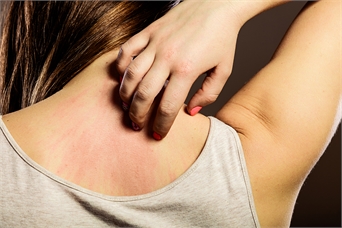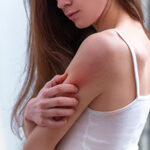
With summer’s warm weather, various irritating skin rashes occur with increase frequency. Five of the more common eruptions are noted below with brief suggestions on prevention and treatment.
- Tinea pedis (athlete’s foot): Heat and moisture create the perfect environment for fungus to proliferate between toes and on the feet.
- PREVENTION: Dry thoroughly after showers (try using a hair dryer on a cool setting after towel). Talc free powder after showers are helpful for individuals who perspire heavily.
- TREATMENT: anti-fungal creams, powders and anti-fungal oral medications in more severe cases.
- Intertrigo: An itchy rash that typically develops in skin folds due to heat, moisture, and friction/rubbing. The groin and the area beneath the breasts are commonly affected.
- PREVENTION: Keep the area dry (see tinea pedis above).
- TREATMENT: antifungal creams and low potency prescription steroid creams.
- Folliculitis: Infected hair follicles that appear like pimples. Often occur in areas of friction, under tight clothing, and in hairy areas.
- PREVENTION: Shower promptly after workouts and change out of tight fitting workout clothes. Wear loose fitting clothing during hot humid weather. Avoid hot tubs if you’re unsure whether the acid and chlorine levels are properly controlled to prevent “hot tub folliculitis”.
- TREATMENT: Wash affected areas in shower with benzoyl peroxide containing soap or cleanser. Sometimes requires topical or oral antibiotic prescription.
- Rhus dermatitis (poison oak, ivy, sumac): Intensely itchy eruption occurs due to allergy to urushiol, a substance found in these plants. Generally presents on exposed areas of skin but may be spread to other areas by touching.
- PREVENTION: Learn to recognize and avoid contact with these plants before hiking and gardening. Wear long pants and long sleeve shirts when hiking and gardening(also offers sun protection!)
- TREATMENT: Generally requires prescription high potency topical steroids for mild/localized eruptions and oral steroids for widespread/severe cases.
- Sunburn: The sun’s ultraviolet rays (UV) are strong this time of year and most intense between 10 am- 4 pm. The UV is present even on overcast days when it’s not hot and some of the worst sunburns occur under these circumstances.
- PREVENTION: Minimize outdoor activity between peak UV hours. Liberally apply a broad spectrum sunscreen with minimal SPF 30 and reapply ever 2 hours and following water exposure. Wear hats, sunglasses with UV protection, and sun protective clothing.
- TREATMENT: Cool compresses, aloe Vera gel, anti-inflammatory medications, eg, aspirin, ibuprofen.


